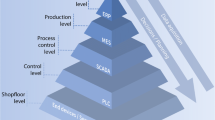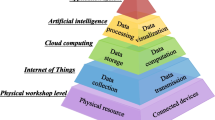Abstract
In the fashion industry, the apparel manufacturing part contains four main processes involving cutting, sewing, finishing, and packing. The complex system deals with configuration of numerous operations and resources in facing of various uncertainties and under constraints of sequence, quantity, time, and cost. Artificial intelligence (AI) has been applied to provide optimal scenario in shorter time than traditional mathematical methods. Big data is helpful due to the ability of prediction for unraveling uncertainties which ensures a smooth and stable production. For improvement of apparel manufacturing in modern fashion industry, it is necessary to develop the capabilities of advanced computing technologies and take great advantage of valuable information that can be dug out from big data.
Access this chapter
Tax calculation will be finalised at checkout
Purchases are for personal use only
Similar content being viewed by others
References
Abeysooriya RP, Fernando TG (2012) Hybrid approach to optimize cut order plan solutions in apparel manufacturing. Int J Inf Technol Commun Res 2
Abeysooriya RP, Fernando TGI (2012b) Canonical genetic algorithm to optimize cut order plan solutions in apparel manufacturing. J Emerg Trends Comput Inf Sci 3(2):150–154
Chen JC, Chen CC, Su LH, Wu HB, Sun CJ (2012) Assembly line balancing in garment industry. Expert Syst Appl 39(11):10073–10081
Fister I, Mernik M, Filipič B (2008) Optimization of markers in clothing industry. Eng Appl Artif Intel 21(4):669–678
Fister I, Mernik M, Filipič B (2010) A hybrid self-adaptive evolutionary algorithm for marker optimization in the clothing industry. Appl Soft Comput 10(2):409–422
Guo ZX, Wong WK, Leung SYS, Fan JT, Chan SF (2006) Mathematical model and genetic optimization for the job shop scheduling problem in a mixed-and multi-product assembly environment: a case study based on the apparel industry. Comput Ind Eng 50(3):202–219
Guo ZX, Wong WK, Leung SYS, Fan JT, Chan SF (2008a) Genetic optimization of order scheduling with multiple uncertainties. Expert Syst Appl 35(4):1788–1801
Guo ZX, Wong WK, Leung SYS, Fan JT, Chan SF (2008b) A genetic-algorithm-based optimization model for solving the flexible assembly line balancing problem with work sharing and workstation revisiting. IEEE Trans Syst Man Cybern C 38(2):218–228
Guo ZX, Wong WK, Leung SYS, Fan JT, Chan SF (2008c) A genetic-algorithm-based optimization model for scheduling flexible assembly lines. Int J Adv Manuf Technol 36(1–2):156–168
Guo ZX, Wong WK, Leung SYS, Fan JT (2009) Intelligent production control decision support system for flexible assembly lines. Expert Syst Appl 36(3):4268–4277
Guo ZX, Wong WK, Leung SYS, Li M (2011) Applications of artificial intelligence in the apparel industry: a review. Text Res J 81(18):1871–1892
Guo ZX, Ngai EWT, Yang C, Liang X (2015) An RFID-based intelligent decision support system architecture for production monitoring and scheduling in a distributed manufacturing environment. Int J Prod Econ 159:16–28
Hajri-Gabouj S (2003) A fuzzy genetic multiobjective optimization algorithm for a multilevel generalized assignment problem. IEEE Trans Syst Man Cybern C 33(2):214–224
Holland JH (1992) Adaptation in natural and artificial systems: an introductory analysis with applications to biology, control, and artificial intelligence. MIT Press
Hui CL, Ng SF (2005) A new approach for prediction of sewing performance of fabrics in apparel manufacturing using artificial neural networks. J Text Inst 96(6):401–405
Hui CL, Ng SF (2009) Predicting seam performance of commercial woven fabrics using multiple logarithm regression and artificial neural networks. Text Res J 79(18):1649–1657
Hui PC, Ng FS, Chan KC (2000) A study of the roll planning of fabric spreading using genetic algorithms. Int J Cloth Sci Tech 12(1):50–62
Hui PL, Chan KC, Yeung KW, Ng FF (2002) Fuzzy operator allocation for balance control of assembly lines in apparel manufacturing. IEEE Trans Eng Manag 49(2):173–180
Hui PC, Chan KC, Yeung KW, Ng FS (2007) Application of artificial neural networks to the prediction of sewing performance of fabrics. Int J Cloth Sci Tech 19(5):291–318
Javanshir H, Rezaei S, Najar SS, Ganji SS (2010) Two dimensional cutting stock management in fabric industries and optimizing the large object’s length. J Res Rev Appl Sci 4(3):243–249
Kim IH, Fok S, Fregene K, Lee DH, Oh TS, Wang DW (2004) Neural network-based system identification and controller synthesis for an industrial sewing machine. Int J Control Autom 2(1):83–91
Koustoumpardis PN, Aspragathos NA (2003) Fuzzy logic decision mechanism combined with a neuro-controller for fabric tension in robotized sewing process. J Intell Rob Syst 36(1):65–88
Koustoumpardis PN, Aspragathos NA (2014) Intelligent hierarchical robot control for sewing fabrics. Robot Comput Integr Manuf 30(1):34–46
Kwong CK, Mok PY, Wong WK (2006) Determination of fault-tolerant fabric-cutting schedules in a just-in-time apparel manufacturing environment. Int J Prod Res 44(21):4465–4490
Lee CK, Choy KL, Ho GT, Law KM (2013) A RFID-based resource allocation system for garment manufacturing. Expert Syst Appl 40(2):784–799
Lee CK, Ho GT, Choy KL, Pang GK (2014a) A RFID-based recursive process mining system for quality assurance in the garment industry. Int J Prod Res 52(14):4216–4238
Lee CK, Choy KL, Law KM, Ho GT (2014b) Application of intelligent data management in resource allocation for effective operation of manufacturing systems. J Manuf Syst 33(3):412–422
Lee CK, Choy KL, Ho GT, Lam CH (2016) A slippery genetic algorithm-based process mining system for achieving better quality assurance in the garment industry. Expert Syst Appl 46:236–248
Lin TH (2004) Construction of predictive model on fabric and sewing thread optimization. J Text Eng 50(1):6–11
Lin MT (2009) The single-row machine layout problem in apparel manufacturing by hierarchical order-based genetic algorithm. Int J Cloth Sci Tech 21(1):31–43
Mak KL, Li W (2008) Objective evaluation of seam pucker on textiles by using self-organizing map. IAENG Int J Comput Sci 35(1)
Martens J (2004) Two genetic algorithms to solve a layout problem in the fashion industry. Eur J Oper Res 154(1):304–322
McCulloch WS, Pitts W (1943) A logical calculus of the ideas immanent in nervous activity. Bull Math Biophys 5(4):115–133
M’Hallah R, Bouziri A (2016) Heuristics for the combined cut order planning two-dimensional layout problem in the apparel industry. Int T Oper Res 23(1–2):321–353
Mok PY, Kwong CK, Wong WK (2007) Optimisation of fault-tolerant fabric-cutting schedules using genetic algorithms and fuzzy set theory. Eur J Oper Res 177(3):1876–1893
Mok PY, Cheung TY, Wong WK, Leung SY, Fan JT (2013) Intelligent production planning for complex garment manufacturing. J Intell Manuf 24(1):133–145
Pavlinic DZ, Gersak J (2009) Predicting garment appearance quality. Open Text J 2:29–38
Pavlinić DZ, Geršak J, Demšar J, Bratko I (2006) Predicting seam appearance quality. Text Res J 76(3):235–242
Ruiz-Torres AJ, Ablanedo-Rosas JH, Ho JC (2010) Minimizing the number of tardy jobs in the flowshop problem with operation and resource flexibility. Comput Oper Res 37(2):282–291
Ruiz-Torres AJ, Ho JC, Ablanedo-Rosas JH (2011) Makespan and workstation utilization minimization in a flowshop with operations flexibility. Omega 39(3):273–282
Shu MH, Chiu CC, Nguyen TL, Hsu BM (2014) A demerit-fuzzy rating system, monitoring scheme and classification for manufacturing processes. Expert Syst Appl 41(17):7878–7888
Wong WK (2003a) A fuzzy capacity-allocation model for computerised fabric-cutting systems. Int J Adv Manuf Technol 21(9):699–711
Wong WK (2003b) Optimisation of apparel manufacturing resource allocation using a generic optimised table-planning model. Int J Adv Manuf Technol 21(12):935–944
Wong WK, Chan CK (2001) An artificial intelligence method for planning the clothing manufacturing process. J Text Inst 92(2):168–178
Wong WK, Guo ZX (2010) A hybrid approach for packing irregular patterns using evolutionary strategies and neural network. Int J Prod Res 48(20):6061–6084
Wong WK, Leung SY (2008) Genetic optimization of fabric utilization in apparel manufacturing. Int J Prod Econ 114(1):376–387
Wong WK, Chan CK, Ip WH (2000a) Optimization of spreading and cutting sequencing model in garment manufacturing. Comput Ind 43(1):1–10
Wong WK, Chan CK, Ip WH (2000b) Effects of spreading-table quantities on the spreading-table planning of computerized fabric-cutting system. Res J Text Appar 4(1):25–36
Wong WK, Chan CK, Ip WH (2001) A hybrid flowshop scheduling model for apparel manufacture. Int J Cloth Sci Tech 13(2):115–131
Wong WK, Chan CK, Kwong CK, Mok PY, Ip WH (2005a) Optimization of manual fabric-cutting process in apparel manufacture using genetic algorithms. Int J Adv Manuf Technol 27(1–2):152–158
Wong WK, Leung SY, Au KF (2005b) Real-time GA-based rescheduling approach for the pre-sewing stage of an apparel manufacturing process. Int J Adv Manuf Technol 25(1–2):180–188
Wong WK, Mok PY, Leung SY (2006a) Develo** a genetic optimisation approach to balance an apparel assembly line. Int J Adv Manuf Technol 28(3–4):387–394
Wong WK, Kwong CK, Mok PY, Ip WH (2006b) Genetic optimization of JIT operation schedules for fabric-cutting process in apparel manufacture. J Intell Manuf 17(3):341–354
Yang CL, Huang RH, Huang HL (2011) Elucidating a layout problem in the fashion industry by using an ant optimisation approach. Prod Plan Control 22(3):248–256
Yeung LH, Tang WK (2003) A hybrid genetic approach for garment cutting in the clothing industry. IEEE Trans Ind Electron 50(3):449–455
Yuan L, Tang W (2017) A compact broadband UHF RFID tag antenna for metallic objects. In: Applied computational electromagnetics society symposium (ACES), Suzhou, 28 September 2017
Yuen CW, Wong WK, Qian SQ, Chan LK, Fung EH (2009a) A hybrid model using genetic algorithm and neural network for classifying garment defects. Expert Syst Appl 36(2):2037–2047
Yuen CW, Wong WK, Qian SQ, Fan DD, Chan LK, Fung EH (2009b) Fabric stitching inspection using segmented window technique and BP neural network. Text Res J 79(1):24–35
Zacharia PT (2010) An adaptive neuro-fuzzy inference system for robot handling fabrics with curved edges towards sewing. J Intell Rob Syst 58(3–4):193–209
Zacharia P, Aspragathos N, Mariolis I, Dermatas E (2009) A robotic system based on fuzzy visual servoing for handling flexible sheets lying on a table. Ind Robot 36(5):489–496
Zadeh LA (1965) Fuzzy sets. Inform Control 8:338–353
Zadeh LA (1966) Fuzzy sets. Fuzzy sets, fuzzy logic, and fuzzy systems: selected papers by Lotfi A Zadeh, pp 394–432
Zeng X, Wong WK, Leung SY (2012) An operator allocation optimization model for balancing control of the hybrid assembly lines using Pareto utility discrete differential evolution algorithm. Comput Oper Res 39(5):1145–1159
Zoumponos GT, Aspragathos NA (2008) Fuzzy logic path planning for the robotic placement of fabrics on a work table. Robot Comput Integr Manuf 24(2):174–186
Zoumponos GT, Aspragathos NA (2010) A fuzzy strategy for the robotic folding of fabrics with machine vision feedback. Ind Robot 37(3):302–308
Author information
Authors and Affiliations
Corresponding author
Editor information
Editors and Affiliations
Rights and permissions
Copyright information
© 2018 Springer Nature Singapore Pte Ltd.
About this chapter
Cite this chapter
Xu, Y., Thomassey, S., Zeng, X. (2018). AI for Apparel Manufacturing in Big Data Era: A Focus on Cutting and Sewing. In: Thomassey, S., Zeng, X. (eds) Artificial Intelligence for Fashion Industry in the Big Data Era. Springer Series in Fashion Business. Springer, Singapore. https://doi.org/10.1007/978-981-13-0080-6_7
Download citation
DOI: https://doi.org/10.1007/978-981-13-0080-6_7
Published:
Publisher Name: Springer, Singapore
Print ISBN: 978-981-13-0079-0
Online ISBN: 978-981-13-0080-6
eBook Packages: Business and ManagementBusiness and Management (R0)




